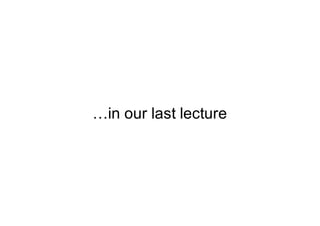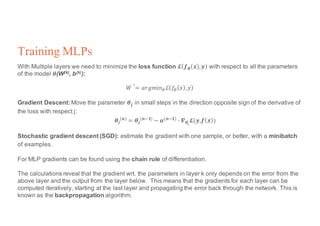Backpropagation (DLAI D3L1 2017 UPC Deep Learning for Artificial Intelligence)
- 1. [course site] Day 3 Lecture 1 Backpropagation Elisa Sayrol
- 2. 2 Acknowledgements Kevin McGuinness [email protected] Research Fellow Insight Centre for Data Analytics Dublin City University
- 3. …in our last lecture
- 4. Multilayer perceptrons When each node in each layer is a linear combination of all inputs from the previous layer then the network is called a multilayer perceptron (MLP) Weights can be organized into matrices. Forward pass computes 𝐚(#)
- 5. Training MLPs With Multiple layers we need to minimize the loss function 𝓛 𝒇 𝜽 𝒙 , 𝒚 with respect to all the parameters of the model 𝜽(W(k), b(k)): 𝑊 ∗ = 𝑎𝑟𝑔𝑚𝑖𝑛4ℒ 𝑓4 𝑥 , 𝑦 Gradient Descent: Move the parameter 𝜽𝒋 in small steps in the direction opposite sign of the derivative of the loss with respect j: 𝜽𝒋 (𝒏) = 𝜽𝒋 (𝒏<𝟏) − 𝜶(𝒏<𝟏) @ 𝜵 𝜽𝒋 𝓛(𝒚,𝒇 𝒙 ) Stochastic gradient descent (SGD): estimate the gradient with one sample, or better, with a minibatch of examples. For MLP gradients can be found using the chain rule of differentiation. The calculations reveal that the gradient wrt. the parameters in layer k only depends on the error from the above layer and the output from the layer below. This means that the gradients for each layer can be computed iteratively, starting at the last layer and propagating the error back through the network. This is known as the backpropagation algorithm.
- 6. • Computational Graphs • Examples applying chain of rule in simple graphs • Backpropagation applied to Multilayer Perceptron • Issues on Backpropagation and training Backpropagation algorithm
- 7. Computational graphs z x y x u(1) u(2) · + y^ x w b σ U(1) U(2) matmul + H X W b relu u(1) u(2) · y^ x w λ x u(3) sum sqrt 𝑧 = 𝑥𝑦 𝑦C=𝜎(xFw + b) 𝑯=max 0, 𝑿𝑾 + 𝒃 𝑦C=xFw 𝜆 P 𝑤R S R From Deep Learning Book
- 8. Computational graphs Applying the Chain Rule to Computational Graphs 𝑦 = 𝑔(𝑥) 𝑧 = 𝑓 𝑔 𝑥 𝑑𝑧 𝑑𝑥 = 𝑑𝑧 𝑑𝑦 𝑑𝑦 𝑑𝑥 𝜕𝑧 𝜕𝑥R = P 𝜕𝑧 𝜕𝑦V 𝜕𝑦V 𝜕𝑥RV 𝛻𝒙 𝑧 = 𝜕𝒚 𝜕𝒙 F 𝛻𝒚 𝑧 𝑑𝑧 𝑑𝑦 𝑑𝑦 𝑑𝑥X 𝑑𝑦 𝑑𝑥S 𝑑𝑧 𝑑𝑥X 𝑑𝑧 𝑑𝑥S 𝑑𝑧 𝑑𝑥X = 𝑑𝑧 𝑑𝑦 𝑑𝑦 𝑑𝑥X 𝑑𝑧 𝑑𝑥S = 𝑑𝑧 𝑑𝑦 𝑑𝑦 𝑑𝑥S For vectors: 𝑥X 𝑥S 𝑦 𝑧 fg 𝑑𝑧 𝑑𝑦 𝑧 = 𝑓(𝑦)
- 9. Computational graphs Numerical Examples From Stanford Course: Convolutional Neural Networks for Visual Recognition 2017 + x 𝑓 𝑥, 𝑦, 𝑧 = 𝑥 + 𝑦 𝑧 𝑥 𝑦 𝑧 𝑞 −2 5 −4 -12 3 𝑞 = 𝑥 + 𝑦 𝑓 = 𝑞𝑧 𝜕𝑞 𝜕𝑥 = 1 𝜕𝑞 𝜕𝑦 = 1 𝜕𝑓 𝜕𝑞 = 𝑧 𝜕𝑓 𝜕𝑧 = 𝑞 𝑊𝑒 𝑤𝑎𝑛𝑡 𝑡𝑜 𝑐𝑜𝑚𝑝𝑢𝑡𝑒: 𝜕𝑓 𝜕𝑥 , 𝜕𝑓 𝜕𝑦 , 𝜕𝑓 𝜕𝑧 𝐸𝑥𝑎𝑚𝑝𝑙𝑒 𝑥 = −2, 𝑦 = 5, 𝑧 = −4 𝜕𝑓 𝜕𝑓 = 1 𝜕𝑓 𝜕𝑓 = 1 1 𝜕𝑓 𝜕𝑞 = 𝑧 = −4 -4 𝜕𝑓 𝜕𝑧 = 𝑞 = 3 𝜕𝑓 𝜕𝑥 = 𝜕𝑓 𝜕𝑞 𝜕𝑞 𝜕𝑥 = −4 · 1 = −4 𝜕𝑓 𝜕𝑦 = 𝜕𝑓 𝜕𝑞 𝜕𝑞 𝜕𝑦 = −4 · 1 = −4 -4 -4 3
- 10. Computational graphs Numerical Examples x +𝑓 𝑥, 𝑦, 𝑧 = 𝜎 𝑤k 𝑥k + 𝑤X 𝑥X + 𝑏 𝑤0 𝑥0 𝑏 x 𝑤1 𝑥1 + σ 𝑑𝜎(𝑥) 𝑥 = 𝑒<m 1 + 𝑒<m 2 = 1 + 𝑒<m − 1 1 + 𝑒<m 1 1+ 𝑒<m 𝜎 𝑥 = 1 1 + 𝑒<m 2 −1 −3 −2 −3 −2 6 4 1 0.73 1 𝑑𝜎(𝑥) 𝑥 = (1 − 𝜎(𝑥))(𝜎(𝑥)) 0,20,2 0,2 -0,2 0,2 0,2 0,4 -0,4 -0,6 From Stanford Course: Convolutional Neural Networks for Visual Recognition
- 11. Computational graphs Gates. Backward Pass 𝜎 𝑥 = 1 1 + 𝑒<m 𝑑𝜎(𝑥) 𝑥 = (1 − 𝜎(𝑥))(𝜎(𝑥)) 𝑞 = 𝑥 + 𝑦 𝜕𝑞 𝜕𝑥 = 1 𝜕𝑞 𝜕𝑦 = 1 𝑓 = 𝑞𝑧 𝜕𝑓 𝜕𝑞 = 𝑧 𝜕𝑓 𝜕𝑧 = 𝑞 Sum: Distributes the gradient to both branches Product: Switches gradient weigth values Max: Routes the gradient only to the higher input branche (not sensitive to the lower branche) 𝑥 𝑦 -0,2 0,2 0 max 2 1 2 + In general: Derivative of a function Add branches: Branches that split in the forward pass and merge in the backward pass, add gradients
- 12. Computational graphs Numerical Examples From Stanford Course: Convolutional Neural Networks for Visual Recognition 2017 x 𝑓 𝑥, 𝑊 = 𝑾 @ 𝒙 2 = P 𝑾 @ 𝒙 R S = P 𝒒 R S p RqX p RqX 𝑾 𝒙 𝒒 0,16 𝜕𝑓 𝜕𝑞R = 2𝑞R 1 𝛻 𝑾 𝑓 = 2𝒒 @ 𝒙F L2 0.1 0.5 −0.3 0.8 0.2 0.4 0.22 0.26 0.44 0.52 0.088 0.176 0.104 0.208 𝛻𝒒 𝑓 = 2𝒒 𝛻𝒙 𝑓 = 2𝑾 𝑇 @ 𝒒 −0.112 0.636
- 13. Backpropagation applied to Multilayer Perceptron For a single neuron with its linear and non-linear part ℎX w g(·) ℎS x ℎX wyX 𝒂xyX 𝒉xyX = 𝑔(𝑾x 𝒉x +𝒃x) = 𝑔(𝒂xyX) 𝜕𝒉x 𝜕𝒂x = 𝑔|(𝒂x) 𝜕𝒉𝒂xyX 𝜕𝒉x = 𝑾 𝒌
- 14. Probability Class given an input (softmax) h2 h3a3 a4 h4 Loss Hidden Hidden Output W2 W3 x a2 Input W1 Figure Credit: Kevin McGuiness Forward Pass
- 15. Probability Class given an input (softmax) Loss function; e.g., negative log-likelihood (good for classification) h2 h3a3 a4 h4 Loss Hidden Hidden Output W2 W3 x a2 Input W1 Regularization term (L2 Norm) aka as weight decay Figure Credit: Kevin McGuiness Forward Pass
- 16. Probability Class given an input (softmax) Minimize the loss (plus some regularization term) w.r.t. Parameters over the whole training set. Loss function; e.g., negative log-likelihood (good for classification) h2 h3a3 a4 h4 Loss Hidden Hidden Output W2 W3 x a2 Input W1 Regularization term (L2 Norm) aka as weight decay Figure Credit: Kevin McGuiness Forward Pass
- 17. 1. Find the error in the top layer: h2 h3a3 a4 h4 Loss Hidden Hidden Output W2 W3 x a2 Input W1 L Figure Credit: Kevin McGuiness Backward Pass
- 18. 1. Find the error in the top layer: 2. Compute weight updates h2 h3a3 a4 h4 Loss Hidden Hidden Output W2 W3 x a2 Input W1 L Figure Credit: Kevin McGuiness Backward Pass To simplify we don’t consider the biass
- 19. 1. Find the error in the top layer: 3. Backpropagate error to layer below2. Compute weight updates h2 h3a3 a4 h4 Loss Hidden Hidden Output W2 W3 x a2 Input W1 L Figure Credit: Kevin McGuiness Backward Pass To simplify we don’t consider the biass
- 20. Issues on Backpropagation and Training Gradient Descent: Move the parameter 𝜃Vin small steps in the direction opposite sign of the derivative of the loss with respect j. 𝜃(p) = 𝜃(p<X) − 𝛼 p<X @ 𝛻4ℒ 𝑦, 𝑓 𝑥 − 𝜆𝜃 p<X Weight Decay: Penalizes large weights, distributes values among all the parameters Stochastic gradient descent (SGD): estimate the gradient with one sample, or better, with a minibatch of examples. Momentum: the movement direction of parameters averages the gradient estimation with previous ones. Several strategies have been proposed to update the weights: optimizers
- 21. Weight initialization Need to pick a starting point for gradient descent: an initial set of weights Zero is a very bad idea! Zero is a critical point Error signal will not propagate Gradients will be zero: no progress Constant value also bad idea: Need to break symmetry Use small random values: E.g. zero mean Gaussian noise with constant variance Ideally we want inputs to activation functions (e.g. sigmoid, tanh, ReLU) to be mostly in the linear area to allow larger gradients to propagate and converge faster. 0 tanh Small gradient Large gradient bad good
- 22. In the backward pass you might be in the flat part of the sigmoid (or any other activation function like tanh) so derivative tends to zero and your training loss will not go down “Vanishing Gradients”
- 23. Note on hyperparameters So far we have lots of hyperparameters to choose: 1. Learning rate (α) 2. Regularization constant (λ) 3. Number of epochs 4. Number of hidden layers 5. Nodes in each hidden layer 6. Weight initialization strategy 7. Loss function 8. Activation functions 9. …

![[course site]
Day 3 Lecture 1
Backpropagation
Elisa Sayrol](https://image.slidesharecdn.com/dlai2017d3l1backpropagation-171017132337/85/Backpropagation-DLAI-D3L1-2017-UPC-Deep-Learning-for-Artificial-Intelligence-1-320.jpg)





















